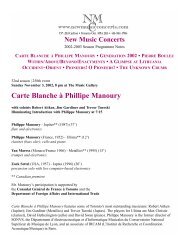2004-2005 Season The Hammerhead Consort - New Music Concerts
2004-2005 Season The Hammerhead Consort - New Music Concerts
2004-2005 Season The Hammerhead Consort - New Music Concerts
You also want an ePaper? Increase the reach of your titles
YUMPU automatically turns print PDFs into web optimized ePapers that Google loves.
sensuality, future and doubt.<br />
Nicolas Gilbert was born in 1979 and lives in Montreal, Canada. His works have been presented in festivals<br />
and special events in Montreal, Toronto, Beijing, Shanghai, Venice, Tallinn and other cities around the world,<br />
performed by ensembles such as the Estonian National Symphony Orchestra, the Ensemble Contemporain de<br />
Montréal - relève, the Trio Fibonacci (Montreal), the Quasar saxophone quartet (Montreal), the Kovalis Duo<br />
(Montreal-Edmonton), the Autograph <strong>New</strong> <strong>Music</strong> Workshop (Yekaterinburg), soprano Janice Jackson<br />
(Halifax), and many others. He received several grants from the Canada Council for the Arts, the Conseil des<br />
arts et des lettres du Québec and from the Fonds québécois de recherche sur la société et la culture. He is<br />
resident composer at the Chapelle Historique du Bon-Pasteur in Montreal and president of the Codes d’accès<br />
Society, founded in 1985 and dedicated to promoting contemporary music in unconventional contexts.<br />
Nicolas Gilbert received his formal training at the Conservatoire de musique de Montréal where he studied<br />
composition with Michel Gonneville and analysis with Serge Provost. He obtained, in 2003, le Prix avec<br />
Grande Distinction in composition and analysis. He also intensively studied foreign languages at the<br />
Université de Montréal, McGill University (Montreal), Nankai University (Tianjin, China) and St-Petersburg<br />
State University (Russia). His current projects include commissions by cellist Benjamin Carat (France) and by<br />
pianist Kadri-Ann Sumera (Estonia-Germany).<br />
D. Andrew Stewart<br />
D. Andrew Stewart ¨on tour¨ with Ensemble contemporain de Montréal<br />
<strong>Music</strong> is inherent in Tom Thomson’s <strong>The</strong> West Wind (1917) and Lawren Harris’ North Shore, Lake Superior<br />
(1926). <strong>The</strong>ir themes are <strong>Music</strong> is inherent in Tom Thomson’s <strong>The</strong> West Wind (1917) and Lawren Harris’<br />
North Shore, Lake Superior (1926). <strong>The</strong>ir themes are enough alike to associate the two works. That is to say,<br />
both paintings depict the movement of clouds, water, light and the momentum of the land in relation to the<br />
subject, a tree; however, each has its unique way of describing this motion. Thomson’s subject is a poetic<br />
metaphor for the tree as the harp of the wind. Its constant motion is flowing and vibrant in that the tree<br />
‘resonates’ in unison with the undulatory movement of its surroundings. One can imagine floating through the<br />
arc of Thomson’s tree.<br />
Harris’ depiction of an erect dead tree trunk is a sculpture rather than a painting. <strong>The</strong> effect of its hard lines is<br />
austere, yet the trunk is shapely and polished to the point where it seems corporeal — like an erect penis.<br />
<strong>The</strong> horizon line is very low, thus the trunk is set against a blue sky and clouds. <strong>The</strong> clouds are equally precise<br />
in line and allude to the human form in their perfect roundness and evenly spaced creases. Straight shafts of<br />
light illuminate the left side of the tree, adding to the sublime shimmering of the entire work. Harris’ painting<br />
resonates pure tones. His tree is more like a tuning fork and is ultimately the source of movement.<br />
I modeled my musical textures after these two paintings.<br />
I composed dense polyphony in which the voices work harmoniously to resonate a composite fabric —<br />
Thomson’s reverberating environment. I created a pseudo-monophonic texture in which distinct voices cooperate<br />
to form one melody — Harris’ single source of vibration.<br />
Asynchrony is another noteworthy feature of this composition. Melody and harmony are never vertically<br />
aligned, except for a few short episodes. For example, two voices playing the same melody do not play the<br />
same note simultaneously — never together on the beat.




